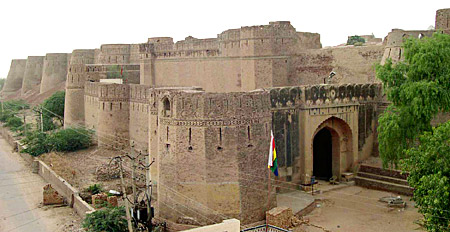In the northern part of the state of Rajasthan, Hanumangarh is a town which is located on the banks of the river Ghaggar.This Hanumangarh town is also the `administrative seat` of Hanumangarh District.
 The formation of this beautiful town of Hanumangarh too is quite significant. As per the records of the historians, the town of Hanumangarh was the empire of `Bhati` Rajputs and therefore its former name was `Bhatner`. There was an ancient `Bhatner` fort that is located in the center of the town of Hanumangarh. It is about nine hundred years So much so that in the `Aaine-Akbari` , mention has been made of this fort. A renowned `Bhadrakali temple` can also be found near the city on the banks of river of Ghaggar river.
The formation of this beautiful town of Hanumangarh too is quite significant. As per the records of the historians, the town of Hanumangarh was the empire of `Bhati` Rajputs and therefore its former name was `Bhatner`. There was an ancient `Bhatner` fort that is located in the center of the town of Hanumangarh. It is about nine hundred years So much so that in the `Aaine-Akbari` , mention has been made of this fort. A renowned `Bhadrakali temple` can also be found near the city on the banks of river of Ghaggar river.
Exquisite works of art and architecture too can be found in the nearby areas of the area Hanumangarh. All these are quite old. Quite a number of terracotta tiles for decoration are found in the late Kushana style. Few more coins too are also been found. There are other things that too are being excavated from the region. For example, two terracotta capitals having the depth of 15` from the peak of the mound with `stepped pyramids` along their boundaries have also been found out.
Geographical location of the Hanumangarh town too throws light some information about it. It is situated at 29.58° N 74.32° E. Also it has an average altitude of 177 metres or 580 feet.
After conducting numerous surveys in the town for quite a period of time, eminent demographers have come up with some significant data about the lifestyle and population figures of the Hanumangarh town. As per the report of the Census of the year 2001, they found that the Hanumangarh had a populace of 129,654. Out of it, the number of males of the Hanumangarh town comprises of 54 percent while females constitutes of 46 percent. In addition, 14 percent of the population is below the age of six years.
Literacy rate too is also quite significant in depicting the situation of the town of Hanumangarh. Remarkably, the average literacy rate of the Hanumangarh town is much higher than that of the average of the entire nation. Average literacy rates of Hanumangarh and India are 65 and 59.5 percent respectively. To be specific, male literacy rate constitutes 72 percent while female literacy rate is 57 percent.
Several personalities also have come from this town of Hanumangarh. These are
Choudhary Shopat Singh, MLA; Choudhary Hari Ram, MP; Choudhary Atma Ram, MLA; Mr. Ram Singh, B.A., M.A., L.L.B., Counsellor.
In order to make it easily accessible to other states of India, both rail and roadways have been built. `Hanumangarh Junction` is a main railway station on Jodhpur-Bikaner-Kalka rout; Sadulpur,Rewari, Sriganganagar, Anupgarh, (Canaloop) ,Jaipur,. Both meter gauge and broad gauge lines `passes` through this station of Hanumangarh. There is also a Diamond-Railway-Crossing. From Hanumangarh to Suratgarh, the broad-gauge begun in the year of 1982 .
In Hanumangarh city, several educational institutes too have been formed. Nehru Memorial P.G. College, Nehru Memorial Children`s School ,National Public School are some of the important institutes. Famous professors include Professor R.S.Sharma, Professor YPS Yadav, Professor Kalra, Professor Randhawa, Professor Bhullar, Professor Saini, Professor L.K.Sharma-Gold Medalist, and Professor Cheema.
As far as the languages are concerned, the people of the Hanumangarh town converses with each other in the famous dialect of Bagri . It belongs to the famous Rajasthani language. Apart from it , there are quite a handful of people who also have developed fluency in languages like Hindi, Punjabi, and Urdu.



















